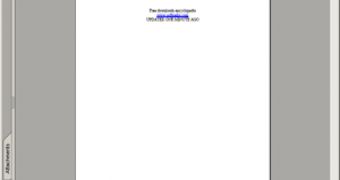Modern computers tend to replace more and more machines and one conclusive example is the typewriter which is ready for extinction. It can be found in third world countries where the technology barely manages to penetrate. For the best results, a computer must have a powerful word processor installed and thank God there are some available that can do the job very well.
Text documents "live" on our computers using specific file extensions like: TXT, RTF or DOC. Some are simple, containing just text (TXT), some evolved so much that they can store not only text information but also images, graphs and hyperlinks. Besides these formats there is a fearful one, hated by the students: PDF.
What is the PDF format?
Portable Document Format (PDF) is an open file format created and controlled by Adobe Systems, to represent two-dimensional documents in a device independent and resolution independent fixed-layout document format. Each PDF file encapsulates a complete description of a 2D document that includes the text, fonts, images, and 2D vector graphics that compose the document. PDF files do not encode information that is specific to the application software, hardware, or operating system used to create or view the document. This feature ensures that a valid PDF will render exactly the same regardless of its origin or destination (but depending on font availability when fonts are not encapsulated in the file).
Why is this format different than the ones mentioned above and why is it hated by some people? First of all, this format is not editable. To open such a file you need to run Adobe Acrobat Reader on your computer, but it can only view the contents of the file without permitting you to edit it as a regular word processor can do with a doc file for example.
For those who need to create paperwork, for the university let's say, such a file gets them nervous because they know they won't be able to edit it. You may immediately react and say that with a converter we can transform the PDF file into an editable text document. That's true, but such a software costs money. I want to provide you a technique you may have not known.
Copy text fragments directly from Adobe Acrobat Reader
The text inside a PDF document is not locked as you might have thought. It can be copied from the document for later editing in a word processor. Acrobat Reader provides this option. Open the targeted PDF document and right click on it. From the menu select "Allow Hand tool to select text". Once this option is enabled, you will be able to perform text selection and copy it to the clipboard. Place the hand cursor over the text and you will see it will change into a text selector letting you select and copy the desired text. Then just paste it into a word processor and edit it at your will.
Copy images as well
Even images can be copied from a PDF document. The option mentioned above must be enabled in this situation tool. Now place the cursor over the image and it will morph into a cross cursor. Select the image and copy it to clipboard. It is stored now in the clipboard memory. You just need to paste it into an image editor and save it to a common image format. Microsoft Paint is enough for this operation.
Take screenshots
Let's say you have created your own PDF document containing text and images and you want to take a snapshot of a partial aria of it as a sample. No need to install a special application. Go to the Acrobat Reader's toolbar and click on the Snapshot Tool. Then make a square selection of the area you want to snapshot and right click on it to copy the selected graphic. Now do as I mentioned about copying images: paste it into an image editor.
Happy ripping!

 14 DAY TRIAL //
14 DAY TRIAL // 


